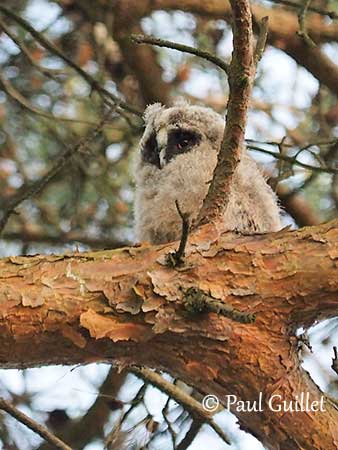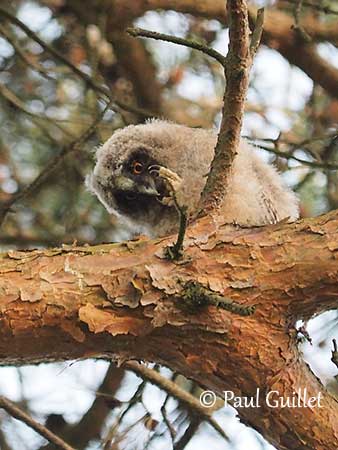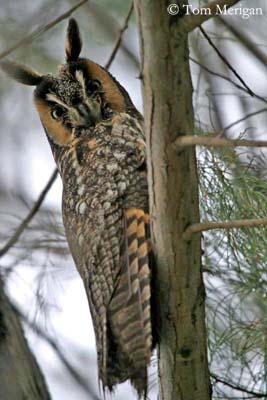
Long-eared Owl
Asio otus
Strigiforme Order – Strigidae Family
BIOMETRICS:
Length: M : 35-38 cm – F : 37-40 cm
Wingspan: 90-100 cm
Weight: M: 220-305 g – F: 260-435 g
DESCRIPTION:
Long-eared Owl is medium-sized. It has brown and buff plumage, heavily mottled and barred over most of its body. Upperparts are mottled with black, buff, brown and white.
Underparts are more whitish-grey, or buff, with brown vertical streaks and barring.
It has rounded wings and long tail. Wings are very long and cross each other in the back when perched.
Fr: Hibou moyen-duc
All : Waldohreule
Esp: Búho Chico
Ital: Gufo comune
Nd: Ransuil
Russe: Ушастая сова
Sd: Hornuggla
Photographers:
Tom Grey
Tom Grey's Bird Pictures
Paul Guillet
Photos d’Oiseaux
René Lortie
http://rlortie.ca
Tom Merigan
Tom Merigan’s Photo Galleries
Text by Nicole Bouglouan
Sources:
HANDBOOK OF THE BIRDS OF THE WORLD Vol 5 by Josep del Hoyo-Andrew Elliott-Jordi Sargatal - Lynx Edicions - ISBN: 8487334253
THE HANDBOOK OF BIRD IDENTIFICATION FOR EUROPE AND THE WESTERN PALEARCTIC by Mark Beaman, Steve Madge - C.Helm - ISBN: 0713639601
THE COMPLETE BOOK OF BRITISH BIRDS – Written by “Royal Society for the Protection of Birds” experts - Préface de Magnus Magnusson - Michael Cady- Rob Hume Editors - ISBN: 0749509112
Pájaros de España (JL Beamonte)
All About Birds (Cornell Lab of Ornithology)

Head is large and rounded, but we can see two long blackish ear tufts, not visible in flight. They are located near the centre of the head.
Long-eared Owl has a large prominent rusty-brown facial disk, edged with black and grey. Eyebrows and lores are white. Bill is black. Eyes are orange or yellow. Legs and feet are feathered.
Some variations of colour may be observed, according to the range, between North America and Eurasia.
Female is darker, more coloured and larger than male.
Juvenile resembles adult, but with softer and looser feathers.
VOICE: SOUNDS BY XENO-CANTO
Long-eared Owl is rather silent outside breeding season, and at this period, they have a wide repertoire to communicate between them.
Most common calls are soft and musical hoots, but quite far-carrying “ooh”. We can also hear quavering hoots. When excited, it shrieks or whistles.
First calls of the series are soft and low-pitched. Females utter weak and nasal “paah” or “peh-ev”. Alarm calls are sharp, barking “kvik-kvik-kvik”.
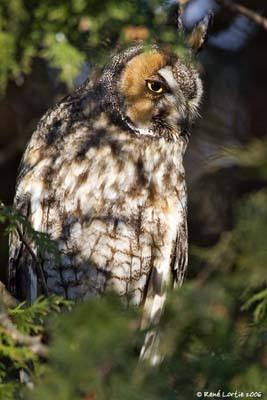
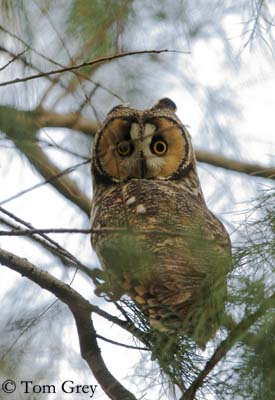
HABITAT:
Long-eared Owl lives in woodlands, copses, thickets and clumps of trees, small plantations in open country.
Outside breeding season, they live in marshes, coastal dunes, steppes and semi-deserts.
RANGE:
Long-eared Owl lives throughout the northern hemisphere, through North America, over Europe to Japan. Some populations are found in North and East Africa, Azores and Canary Islands.
Northern populations migrate southwards in winter, and southern birds are sedentary.

BEHAVIOUR:
Long-eared Owl is a nocturnal bird, hunting mainly at night. It is rarely active by day, except in migration.
It hunts at night, over open fields and marshes. They capture prey using their excellent eyesight and earring. Most preys are captured on the ground or from low vegetation. After capturing prey, Long-eared Owl kills it by biting the back of the skull, and then, it swallows it whole.
They may store excess prey at nest, during incubation and nesting period. Small preys are swallowed or brought in the bill, and larger preys are carried in the talons. They regurgitate pellets three to four hours after eating.
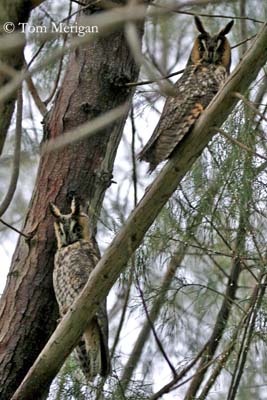
During breeding season, Long-eared Owl defends only the nest-site. They live in pairs at this time, but they may be tolerant of other owls of the same species.
Both parents defend the nest against predators. They circle the nest and snap their bills at the intruder, and they may dive bomb the predator while giving alarm calls. They also feign to be injured to lure the predator, and drawing it away from the nest-site. Sometimes, several adults from nearby nests may perform defence displays, even if a single nest is threatened.
Long-eared Owls are monogamous, and pairs form in winter. They breed from February to mid-July. Males use songs and aerial displays to attract females, performing zigzag flights through the trees into breeding habitat. Displays begin in late winter. Male flies around the nest, performing some acrobatic flights, gliding and flapping through the trees.
FLIGHT:
Long-eared owl is a very talented flier, and may fly through fairly dense brush. Its flight is almost gull-like, with several slow wing beats, alternating with long glides. It glides with wings held level.
REPRODUCTION:
Long-eared Owl nests in wooded places, hidden in dense vegetation. It usually nests in abandoned stick nests, built by other species.
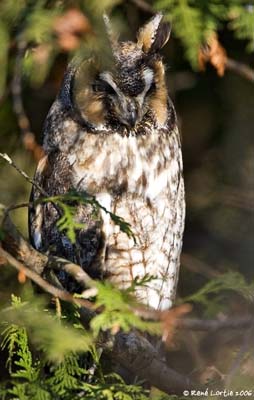
Female lays 4 to 5 white, smooth and glossy eggs. Incubation lasts about 25 to 30 days, by female. She remains at nest all the day, but she takes short breaks at night.
Semi-altricial chicks are brooded by female during two weeks. Young leave the nest at about 3 weeks of age. They are not able to fly, and they stay in the nearby branches and vegetation.
If threatened, the young adopts a threat posture with wings spread in order to appear larger.
At about 35 days after hatching, they begin to perform short flights. They become independent at about 10 to 11 weeks old. Male brings food to female and owlets during incubation and nesting period. Juvénile's calls by Paul Guillet
Young reach their sexual maturity at about one year.
This species produces only one brood par season.
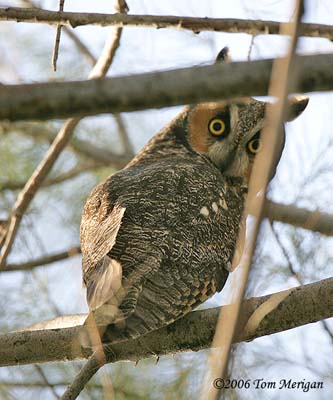
DIET:
Long-eared Owl feeds on small mammals (fewer than 100 g) such as voles, juvenile rabbits and rats. They also may eat small birds, small snakes and insects.
PROTECTION / THREATS / STATUS:
Long-eared Owl adults are preyed upon by larger raptors (owls, eagles, hawks, buzzards). Female at nest may be killed by raccoons. Nestlings are preyed upon by porcupines, snakes and corvidae.
They help to control rodent populations.
Populations of Long-eared Owls appear largely stable, with some local declines, due to starvation and predation, and habitat loss. Adults may be killed by cars.
